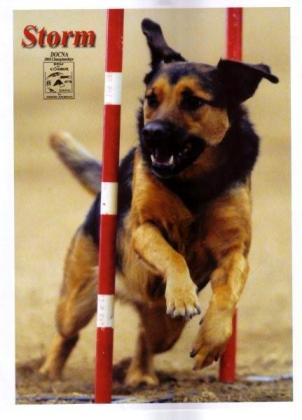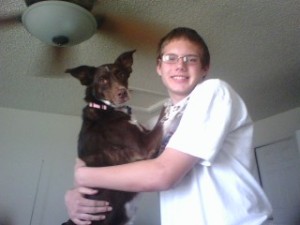A Comparison of Agility Venues
Every competitor has their favorite venue. Usually, it is the one they are most successful in. Some people train skills specific to a particular venue, and therefore favor it. I firmly believe in a balanced agility dog. I want a dog that has the skills to compete in any venue, whether the courses are open and flowing, or tight and technical. We don’t train “for AKC” or “for NADAC”. We train for every conceivable course configuration students are likely to encounter. When students ask which venue they should compete in, the answer is never quick and easy. It depends on their goals, abilities, and personality, along with the personality and ability of the dog.
I don’t disparage venues that I don’t compete in. Every venue has its pros and cons. Some people classify venues as “harder” or “easier”, but my opinion is that to excel in each venue, you have to possess a specific set of skills. Those who criticize particular organizations either dislike the way they are managed, or do not possess (or want to possess) the skills to be as successful there.
In our area, AKC, NADAC, DOCNA, and USDAA are popular; UKC and TDAA are also available, though less popular. The first four venues are the ones I have first-hand experience with and are therefore the ones I will be comparing. I know that in other areas CPE and ASCA are popular. Maybe I’ll research them for a future post.
I’ll start with the venue I am most familiar with, which is NADAC. NADAC offers open, flowing courses, a relaxed atmosphere, and numerous games. Typically, a club will offer five or six runs per day. Course times are very tight, and there is an emphasis placed on speed and distance. For example, at the elite level, in the distance class, dogs are expected to work up to 30’ away from their handlers. Teams that are fast, energetic, and can work at a distance will excel here.
Pros: Generally, trials are friendly and relaxed, competitors are helpful, there are no long waiting periods between classes, and dogs love being able to open up and really run. All dogs are allowed to play, including mixed-breeds and some physically handicapped dogs. Divisions are offered for those who cannot or do not want to jump full height and for veterans.
Cons: There are very few handling challenges in the courses aside from getting fault-free performances at speed, and some dogs are not able to maintain their energy or focus for that many runs per day. Some people feel that it is difficult to “rein in” a dog once they have learned to run extended on open courses.
Necessary skills: Teams must have independent obstacle performance, be able to find weave entries at high speed, and need to maintain contact criteria when running full-out. In addition, the distance game requires the dogs to work further away than other venues. Discriminations are a common course challenge. Finally, dogs must be able to safely perform obstacles and judge jumps when running at high speed.
The next venue to discuss is USDAA. USDAA, in my opinion, is the most physically demanding venue for the dog. They have the highest jump heights, the highest A-frame, the shortest contact zones, and relatively tight times. Courses are usually fairly technical and an emphasis is placed on speed and precision. They offer several runs per day, including strategy games. Teams that are in top physical condition and that like a challenge will enjoy in this venue. This is also the venue to compete in if the goal is international competition.
Pros: There are no long waiting periods between classes, the courses are challenging, and the games are fun. Refusals at the higher levels ensure that a smooth run is required to qualify. All dogs are allowed to play, including mixed-breeds. Divisions are offered for those who cannot or do not want to jump full height or for veterans.
Cons: Some dogs are not able to maintain their energy or focus for multiple runs per day. The courses can be overly challenging for brand new competitors with new dogs. The atmosphere can sometimes be overly-competitive and intimidating for new people.
Necessary skills: Teams must be able to switch between extension and collection, must have the ability to turn sharply after obstacles, and the dogs must be in good physical shape. Moderate distance skills are required for the distance game. Good contact skills are necessary because of the shorter contact zone. Discriminations are frequently used elements in USDAA courses, as are wraps and difficult weave entries.
I do not personally participate in AKC, but many of our students do. AKC is known for highly technical courses, with generous times and moderate jump heights. They offer two or three runs per day, with one strategy/distance game. Teams who enjoy solving multiple handling puzzles will enjoy AKC.
Pros: The courses are technically challenging and refusals ensure that a smooth run is required to qualify at the higher levels. Reasonable jump heights and times allow dogs who are not speed demons to qualify if they have the skills required to complete the courses. The preferred division is offered for those who cannot or do not want to jump full height or for veterans.
Cons: The wait times between runs can be long. Only purebreds are allowed to play, although AKC is changing that policy in 2010. The atmosphere can sometimes be overly-competitive and intimidating for new people. Trials are more formal than most other venues, which is a pro to some competitors. Some people believe that AKC courses are unreasonably hard on bigger dogs because of the tight turns and changes of direction.
Necessary skills: Teams must be able to turn sharply after obstacles, run collected for sequences, and the handlers must have very good technical skills. Discriminations are frequently used elements in AKC courses, as are wraps and difficult weave entries. Threadles and 270s are fairly common elements as well.
DOCNA is a relatively new venue. DOCNA combines flowing courses with some technical challenges in a relaxed atmosphere. The course times are relatively tight. Clubs typically offer 5 or 6 runs per day, including some strategy games. Teams that enjoy challenges but don’t like the sudden turns and abrupt stops will enjoy DOCNA.
Pros: There are no long waiting periods between classes. The courses provide a good balance of flow and technical challenges and the games are fun. All dogs are allowed to play, including mixed-breeds and some physically handicapped dogs. Divisions are offered for those who cannot or do not want to jump full height and for veterans.
Cons: Some dogs are not able to maintain their energy and focus for multiple runs. The venue may not be challenging enough for those who like extremely technical courses.
Necessary skills: Dogs must be able to switch between running collected and running extended. DOCNA courses frequently have contact to tunnel flips in them as well as discriminations. They also use wraps, serpentines, and sequences that encourage the dog to build speed before having to collect for the weaves. A moderate amount of distance is required for the distance game.
Deciding on a venue is a very individual choice. Each person has to determine what their goals are and what they enjoy. Tastes can change over an agility career as well, with people desiring more technical challenges, or looking for a venue that will allow their veteran to play with minimal physical impact. Hopefully this comparison will give you a starting point for your research so you can make the right decision for your team. Happy trialing!




